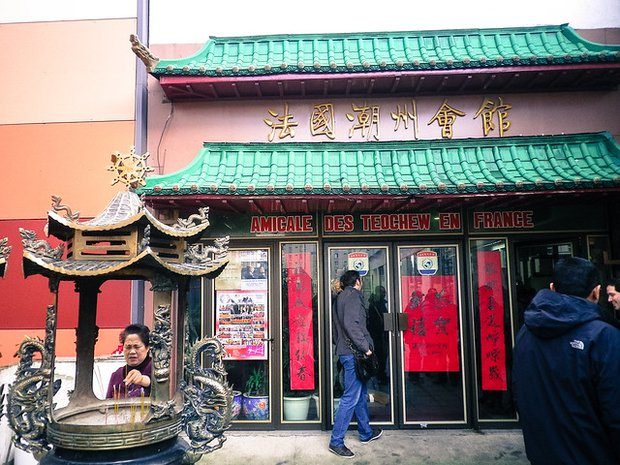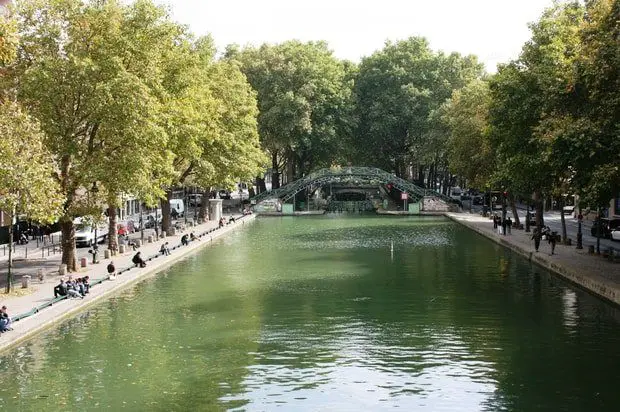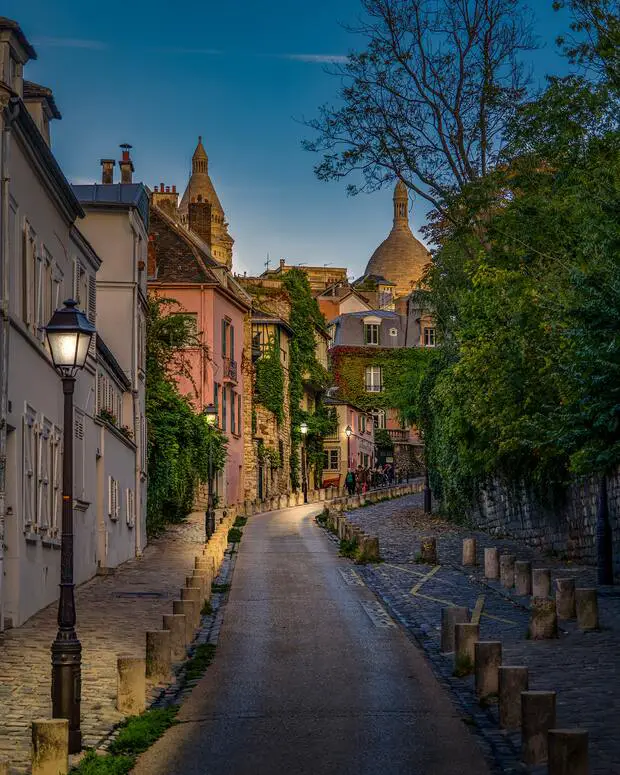Le Marais is one of Paris’s most charming and lively neighborhoods, full of history, art, and delicious food. Whether you’re strolling down cobblestone streets, visiting unique shops, or relaxing in beautiful squares, the Marais has something for everyone. Hopefully, my list will inspire you for your exploration of this iconic district.
First, let’s locate these spots on a map:
Want a version of this map you can print or save on your phone?
I’ve created a pack with 13 one-page neighborhood maps—including this one. Each map comes with a quick guide and a QR code that links back to the full guide and the custom Google Map. Perfect for trip planning or exploring on the go.
Place des Vosges
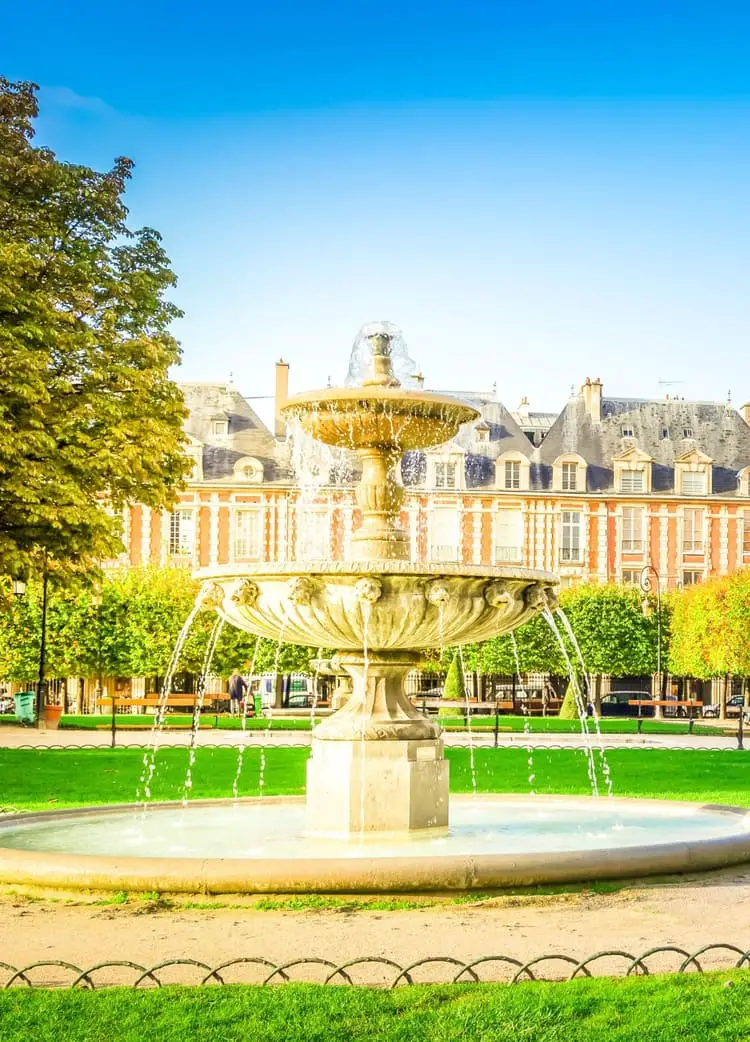
This tranquil spot offers the perfect setting for a leisurely stroll or to relax and take in the view.
Furthermore, the sumptuous private mansions surrounding it were converted into museums, like the Picasso Museum or the House of Victor Hugo.
What I love:
- Captivating museums
- One of Paris’ most elegant squares
- Green spaces perfect for relaxing/picnicking
Musée Carnavalet
23 Rue de Sévigné, 75003 Paris
Voir cette publication sur Instagram
The Musée Carnavalet, dedicated to the history of Paris, is housed in two magnificent townhouses in the Marais district.
Here you will discover collections tracing the development of the capital, with works ranging from prehistory to the present day.
Art lovers will appreciate its exceptional paintings, sculptures, objets d’art and furniture.
The visit also includes immersive spaces, such as reconstructions of Parisian interiors through the ages.
What I love:
- A fascinating dive into the history of Paris
- The museum’s architecture and tranquil gardens
Au Petit Versailles du Marais
1 Rue Tiron, 75004 Paris
Voir cette publication sur Instagram
This bakery is a true jewel in the heart of the Marais.
With its stunning golden decor, it feels like stepping into a royal palace.
The pastries and bread are as beautiful as they are delicious, making it a perfect spot to grab a sweet treat or enjoy a classic Parisian baguette.
What I love:
- The ornate decor and delicious treats
- A quintessential Parisian bakery experience
Carette
25 Place des Vosges, 75003 Paris
Voir cette publication sur Instagram
Carette is a classic Parisian tea room perfect for enjoying delicious pastries, savory snacks, or a warm cup of hot chocolate.
Located by the stunning Place des Vosges, it’s a cozy spot to relax after exploring the Marais.
The chic interior and delightful treats make it a favorite among locals and visitors alike.
Highlights
- The charming location and elegant decor
- Mouthwatering macarons and pâtisseries
La Favorite Saint Paul
6 Rue de Rivoli, 75004 Paris
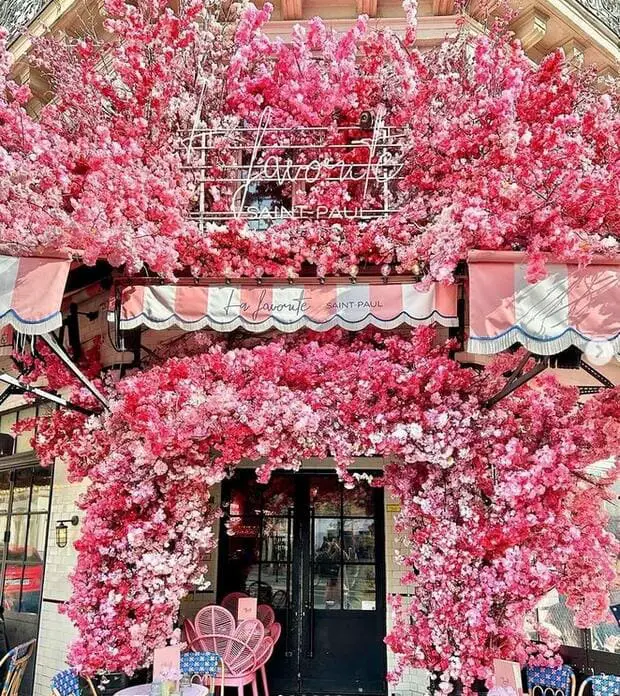
A lively and stylish brasserie known for its Insta-worthy decor and inviting terrace.
Whether for brunch, cocktails, or a casual dinner, La Favorite is a popular hangout in the Marais.
What I love:
- The trendy yet relaxed vibe
- Great people-watching spot!
Poilâne
38 Rue Debelleyme, 75003 Paris
Voir cette publication sur Instagram
Poilâne is a legendary Parisian bakery, celebrated for its rustic sourdough bread made with natural ingredients using time-honored methods.
Don’t miss their buttery apple tarts and famous “punitions” cookies.
Every visit feels like stepping into a delicious slice of Parisian history, making it a must-stop for food lovers.
What I love:
- The rich history and artisanal craftsmanship
- A perfect spot to grab breakfast or a snack
Little Red Door
60 Rue Charlot, 75003 Paris
Voir cette publication sur Instagram
This world-famous cocktail bar feels like stepping into a secret. Hidden behind a discreet red door, it offers a cozy and stylish atmosphere.
The bartenders are like artists, crafting creative drinks with surprising ingredients and stories behind every sip.
It’s a magical place for a unique evening out.
What I love:
- The surprise of discovering its hidden entrance
- Unique, handcrafted cocktails
L’As du Fallafel
34 Rue des Rosiers, 75004 Paris
Voir cette publication sur Instagram
Known as the best falafel in Paris, this bustling spot on Rue des Rosiers is a must-visit.
The pita sandwiches, loaded with crispy falafel and fresh toppings, are worth the queue!
What I love:
- Affordable and delicious street food
- The vibrant street it’s located on
Bisou Bar
15 Boulevard du Temple, 75003 Paris
Voir cette publication sur Instagram
This charming cocktail bar serves drinks made from seasonal, locally sourced ingredients.
The bartender designs a custom cocktail just for you!
What I love:
- The bespoke cocktails
- A cozy and intimate setting
Village Saint-Paul
Rue Saint-Paul, 75004 Paris
Voir cette publication sur Instagram
A hidden gem in the Marais, this charming maze of courtyards is filled with antique shops, art galleries, and cafes.
What I love:
- The quiet, artistic atmosphere
- Finding unique souvenirs or gifts
Quai de l’Hôtel de Ville
Voir cette publication sur Instagram
A scenic promenade along the Seine, perfect for a romantic walk or a leisurely afternoon enjoying the river views.
What I love:
- The serene views of the Seine
- A peaceful escape in the city
Merci (Concept Store)
111 Boulevard Beaumarchais, 75003 Paris
Voir cette publication sur Instagram
This famous concept store in the Marais offers a curated selection of designer clothing, home goods, and unique gifts.
Known for its charitable ethos, profits from Merci go to educational projects in Madagascar.
The iconic little red Fiat parked at the entrance makes it Instagram-worthy, too!
What I love:
- The unique, ever-changing selection of products
- Supporting a great cause while shopping
Officine Universelle Buly
45 Rue de Saintonge, 75003 Paris
Voir cette publication sur Instagram
Step into this beautifully vintage apothecary for perfumes, skincare, and candles inspired by 19th-century aesthetics. Perfect for finding a luxurious Parisian souvenir or indulging in some self-care.
What I love:
- The stunning decor
- Artisanal products with Parisian charm
Saint-Paul-Saint-Louis Church
99 Rue Saint-Antoine, 75004 Paris
Voir cette publication sur Instagram
Built in the 17th century, this Baroque building boasts an imposing dome and magnificent stained glass windows.
Commissioned by Louis XIII, the church reflects the power of French royalty.
Its richly decorated interior houses a famous painting by Delacroix.
What I love:
- Its unique Baroque architecture
- The church’s peaceful setting in the heart of the Marais district
Rue Vieille du Temple
Voir cette publication sur Instagram
Located in the heart of the Marais, this historic street is packed with trendy boutiques, art galleries and restaurants.
It offers a picturesque stroll between old buildings and modern shops.
It’s also a great place to discover the district’s bohemian charm.
What I love:
- The lively atmosphere and many trendy addresses
- Contemporary art galleries
Rue du Trésor
Voir cette publication sur Instagram
Small and hidden, Rue du Trésor is a charming pedestrian street, ideal for getting lost and escaping the hustle and bustle of Paris for a while.
Its colorful facades and cafés make it a popular spot for local residents.
What I love:
- The intimate, picturesque atmosphere
- Its little cafés to linger in
Rue des Rosiers
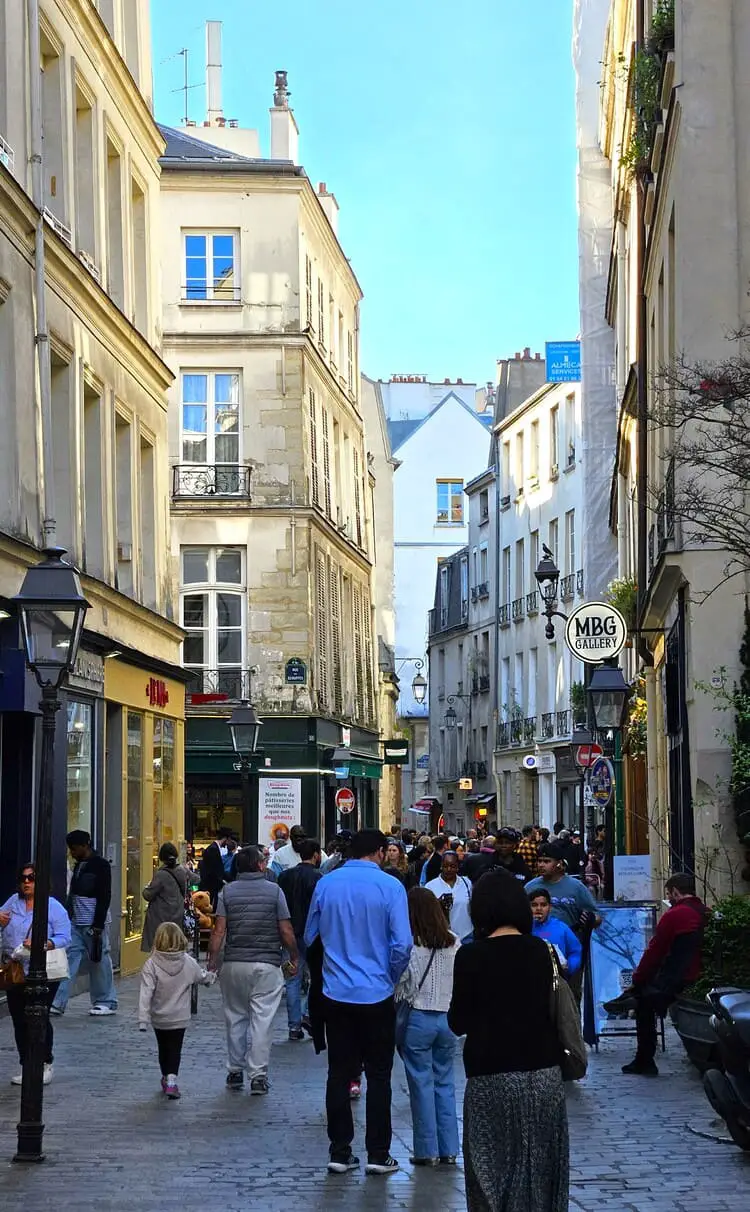
With its quaint cobbled lanes and historic stone façades, this charming street beckons for exploration and is truly a must-see destination.
What I love:
- An enchanting street
- The Jewish eateries on this street
Rue des Barres
Voir cette publication sur Instagram
A charming little cobbled street, Rue des Barres is an invitation to step back in time.
It offers a breathtaking view of the Saint-Gervais church and its well-preserved medieval buildings.
In summer, it’s a pleasant place for a quiet stroll away from the hustle and bustle of the tourist trade.
What I love:
- Its calm, authentic atmosphere
- The cafes and outdoor seating
Rue des Francs-Bourgeois
Voir cette publication sur Instagram
A shopper’s paradise, Rue des Francs-Bourgeois is packed with fashion, jewelry and accessories boutiques.
It runs through one of the most beautiful pedestrian areas in the Marais, making it an ideal place to stroll while discovering the architecture of the townhouses.
What I love:
- Chic shopping in the heart of the Marais
- The beauty of the surrounding architecture
Musée national Picasso
5 Rue de Thorigny, 75003 Paris
Voir cette publication sur Instagram
This museum contains the largest collection of Picasso’s work in the world.
It’s a great way to find out more about this legendary painter and experience his world-famous works.
What I love:
- The expansive collection of works of art
Marché des Enfants Rouges
Voir cette publication sur Instagram
Being one of the oldest markets in Paris, you’ll discover a stall full of fresh products.
It’s enough to make your mouth water and make you want to cook!
What I love:
- A beautiful covered market
- A pleasant place to visit
Hôtel de Sully
62 Rue Saint-Antoine, 75004 Paris
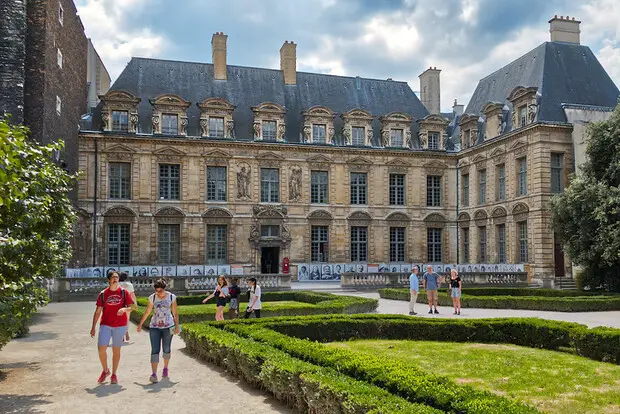
Built in the 17th century, this townhouse is a perfect example of classical Parisian architecture.
Surrounded by superb formal gardens, it is now home to the Caisse Nationale des Monuments Historiques.
Visitors can walk through the courtyard directly to the Place des Vosges.
What I love:
- The tranquillity of its gardens
- The elegant architecture and beautiful proportions of the hotel
Hôtel de Ville (City Hall)
Place de l’Hôtel de Ville, 75004 Paris
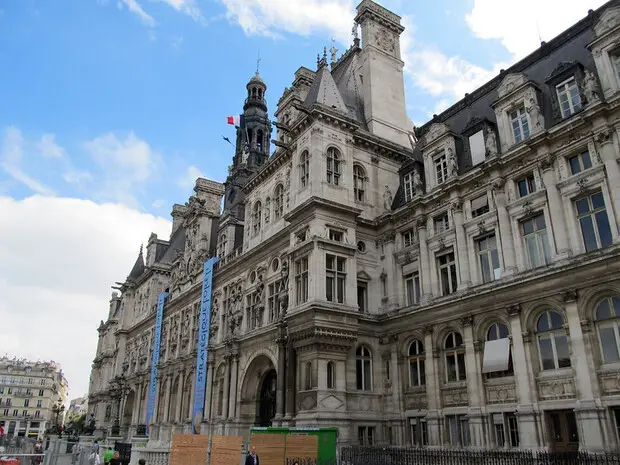
The Hôtel de Ville, the seat of the Paris City Council, is a magnificent neo-Renaissance building.
You can admire its richly decorated façade, visit its rooms for events or simply enjoy the outdoor entertainment, particularly in summer with the festivals, or in winter with the ice rink.
What I love:
- The exhibitions and cultural events, many of which are free
- The grandeur of the architecture
House of Victor Hugo
6 Place des Vosges, 75004 Paris
Voir cette publication sur Instagram
This house, where Victor Hugo lived for 16 years, is now a museum dedicated to the life of the writer.
Here you can discover his world through personal objects, manuscripts and reconstructions of his various flats.
What I love:
- Discovering the private life of one of France’s greatest writers
- The privileged location on the Place des Vosges
Le BHV Marais
52 Rue de Rivoli, 75004 Paris
Voir cette publication sur Instagram
The BHV Marais is one of Paris’s iconic department stores.
Here you’ll find everything from fashion to home decoration and electrical goods.
Its rooftop also offers a breathtaking view of Paris and the Marais district.
What I love:
- The variety of products on offer
- The exceptional view from the terrace
Hôtel de Sens
1 Rue du Figuier, 75004 Paris
Voir cette publication sur Instagram
The Hôtel de Sens is one of the few Gothic townhouses still standing in Paris.
Built in the 15th century, it was home to Queen Margot.
Today it houses a library, and its impressive architecture makes it a must-see for lovers of medieval history and art.
What I love:
- Its architecture, unique in Paris
- Its fascinating history
Péniche Marcounet
Port des Célestins, Quai de l’Hôtel de ville, 75004 Paris
Voir cette publication sur Instagram
Located in front of Ile Saint-Louis, this barge is both a jazz club and a restaurant and provides quite a unique concept.
What I love:
- The unusual setting
- The menu

With a passion for travel and having visited over 50 countries, Dorian is eager to share his favorite spots and expert tips to help you explore Paris and France like a local.


